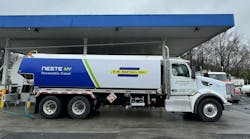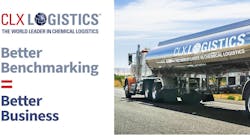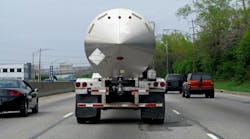THE advent of Comprehensive Safety Assessment (CSA) 2010 has created a new category called “uninsurable drivers,” according to Robert J Henry of Scopelitis, Garvin, Light, Hanson & Feary PC, a full-service transportation law firm.
“An insurance company, having had access to your information, might say, ‘I think you have two drivers you shouldn't really have in your fleet,’ ” he said. “Or, ‘There are criteria related to CSA 2010 you need to follow, and if your driver doesn't follow them, you need to get him out of the fleet.’
“While CSA 2010 is far from finalized and there is a rulemaking process to be completed, some factors help us predict the future. In the insurance industry, there are already certain drivers or categories they don't want to insure.”
He said the current environment serves as “harbinger of things to come,” where there is no coverage for those who are younger than 23, have had three moving violations in three years, a DUI conviction, two preventable accidents, or 49 CFR 391.41 medical causes (such as obesity, which limits movement).
He said there will be uninsurability based on peer-group rankings and Behavior Analysis and Safety Improvement Categories (BASICs), including fitness and fatigue, vehicle MTC and loading/security, and unsafe driving and controlled substance/alcohol. Intervention-level-based uninsurability is still an area of uncertainty. Driver-based automatic disqualifying offenses are the refusal of a drug or alcohol test, positive-test results, invalid CDL due to suspension or revocation, or failing/refusing to submit driver logs.
“There are estimates that 100,000 drivers may be lost as a result of the implementation of CSA 2010,” he said. “That creates an obvious problem: How are you going to get freight moved? It also creates an issue of morale. Some of the drivers who are not going to be around may have been considered good drivers, but they couldn't meet the criteria to stay in fleet.”
There are other impacts of uninsurable drivers: recruiting issues causing increased cost; employment lawsuits; breach-of-contract lawsuits; unemployment benefit claims; insurance coverage gaps and claim denials; and indemnification/reimbursement claims by insurers.
He said current insurance codes could open the door for mid-term cancellations under CSA 2010. For example, a policy in effect for over 60 or 90 days can be cancelled if “the risk originally accepted has measurably increased,” based on Illinois Ins. Code § 143.16a(d); or “there is a substantial change in the scale of risk covered by the policy,” based on Indiana Insurance Code § 27-1-31-2(a)(2).
Case law could support a mid-term cancellation. In New England Insurance Co v Cummings: “Thus, to establish an increase in hazard, there must be evidence of a change in the situation which substantially increases the probability that the event insured against will occur.”
Henry said CSA 2010 is designed to predict and change unsafe behavior that could lead to accidents — as opposed to SafeStat, which measures out-of-service and accident violations to prioritize inspections.
“Current policy ‘cancellation and non-renewal’ endorsements incorporate ‘substantial change in risk’ — language to further support the possibility of mid-term cancellations,” he said. “The threat of cancellation or non-renewal provides insurers economic leverage: premium adjustments by mutual agreement; negotiation over claims due to poorly ranked drivers; and negotiation over law enforcement determination of improperly loaded or unsecured loads resulting in initial cargo claim denials.”
Coverage concerns precipitated by CSA 2010:
-
Claims caused by drivers in a category defined by insurer as “uninsurable drivers.” (Under CSA 2010, even initially insurable drivers can become uninsurable in as little as a few months.)
-
Cargo deemed “improperly stowed” under such cargo policy exclusion due to police determination of loading or load securement problems. Will there be a rebirth of the “improper stowage” exclusion from the 1980s?
-
Physical damage-claims denial due to a high BASIC score in a vehicle-maintenance violation or a high BASIC crash indicator.
-
Losses may become worse as the plaintiffs bar begins to use CSA 2010 to support negligence allegations.
“Currently, one major insurer of broker-liability insurance requires carrier selection criteria to include monitoring of motor carrier safety rating, SEA scores, and ISS score,” he said. “CSA 2010 criteria provide many more levels of carrier selection criteria to monitor and for insurers to require in applications and underwriting restrictions for broker liability coverage. Comparing the almost ‘static’ SafeStat system to the almost real-time and dynamic CSA 2010 system means much more administration will need to be dedicated to carrier-selection criteria for logistics companies — likely daily checks. Insurers and shipper contracts might also require notice of CSA 2010 ranking changes.
“Logistics companies that tend to rely on the very small carriers and smaller carriers will likely present the biggest risk of ‘negligent entrustment’ and greatest cost to monitor. Smaller carriers are less sophisticated on safety and less particular on hiring practices, and are less likely to appeal erroneous law-enforcement submissions.
“Despite peer groupings, smallest carriers may still be more dramatically affected by enforcement stops resulting in a more immediate change of ranking. Unsafe driving and driver fatigue BASICS might be weighted more significantly than the other five BASICs so that positive scores in those five areas may not out-balance the two most sensitive BASICs. Carriers using owner-operators must be certain owner-operators possess CSA 2010 knowledge, but risk weakening independent contractor status through too much training. Independent contractors with drivers should report driver rankings to motor carriers.”Henry provided 10 risk-management steps to consider:
-
Initiate immediate and open lines of communications with insurers on what coverage and underwriting changes they expect under CSA 2010. Use knowledgeable brokers in this process.
-
Include a new notice in orientation manuals stating any driver deemed uninsurable will be terminated or canceled or his contract will be terminated “for cause.”
-
Review cargo policy for “improper stowage” exclusion to evaluate potential for immediate coverage risk.
-
Begin an initial draft protocol to monitor and administer CSA 2010 rankings and include an “insurer's criteria” component.
-
Within logistics operations, review or implement carrier selection guidelines that include SEA score thresholds and routine monitoring to ease into CSA 2010 real-time environment.
-
Draft a provision into the owner-operator agreement requiring the owner-operator and/or its drivers to maintain an acceptable CSA 2010 driver ranking.
-
Draft a notice to owner-operators requiring them to be knowledgeable and familiar (“with proof upon request”) with CSA 2010 information — specifically including driver violations and rankings.
-
Review and revise broker/carrier agreements in your capacity as a logistics provider contracting with motor carriers to ensure indemnification for CSA 2010 compliance problems is specifically addressed
-
Make certain the fleet's FMCSA-published data with regard to power units is currently accurate and file MCS-150 updates routinely.
-
Consider developing a detailed “Enforcement Stop Information Sheet” for drivers to complete that gathers key data on each enforcement stop. This data may be helpful to appeal erroneous enforcement stops.
“Just the Facts”
Thomas Bray
Editor of transport management
J J Keller & Associates
Bray said CSA 2010 is a “system that involves putting SafeStat on steroids and automatically rating carriers based on data, and these ratings then lead to ‘relevant interventions.’ ”
He said CSA 2010 data collection involves:
-
All crash data for DOT-reportable crashes.
-
Roadside inspection data. “This is one of the areas of confusion. It's all violations on roadside inspection.”
-
Intervention data. “They generate a score on you, but then they come to an intervention. That may influence your score. It all ties together at the end.”
Bray said the “driver fitness” portion (Parts 383 and 391) of the seven Behavior Analysis and Safety Improvement Categories (BASICs) draws the most questions.
“That BASIC has nothing to do with push-ups, sit-ups, or running laps around the scale,” he said. “It's about driver qualifications. Does the driver have a license and medical card?”
The BASIC process involves relevant intervention, inspection, violation, and crash data assigned to the carrier; violations and crashes are classified into the correct BASIC; events are time-weighted and severity-weighted; BASICs are totaled and normalized (BASIC measure); and carriers are peer-grouped and compared.
“Regarding the intervention thresholds that have been in use in the pilot states, the bottom line is that preventing violations keeps the BASIC Measure low enough that you do not need to worry about what the thresholds are or how the scoring works,” he said. “The FMCSA may be making minor adjustments to these as the pilot states report back on their workload.
“Interventions will be used for carriers found to be marginal or unfit. The worse the carrier scores in the SMS and SFD, the more aggressive the intervention. A carrier found unfit in the SFD phase will not start at ‘Warning Letter’; they will start at CSP or Consent agreement.
“Warning letters inform the carrier that the FMCSA has seen a problem, and inform the carrier that they need to correct it, or further action will be forthcoming. There is no response required, only improvement. TRE is the equivalent of having a bad ISS-D score presently, roadside inspectors will be ‘looking’ for your vehicles.
“The ‘focused’ interventions involve the auditor only checking the BASIC areas that the carrier is having trouble in. Example: The only BASIC a carrier is having trouble in is Fatigued Drivers (too many drivers found not in compliance with the HOS regulations). The focused on- or off-site investigation will only involve HOS, unless other problems are found or suspected.
“CSA 2010 uses all violations issued at the roadside when calculating carrier compliance. This is a shift your people have to make in their thinking. The golden rule before always was, ‘Was the driver put out of service? Was the vehicle put out of service?’ Now the golden target is a violation-free inspection, because any violation coming in on a roadside inspection report is going to be used to generate your score.
“FMCSA wants a bigger data set to try to locate more carriers in need of help, so they are expanding the data they are using in their decision-making. The result of this is carriers that were fine in SafeStat, but had a high percentage of inspections resulting in non-out-of-service violations are suddenly being contacted by the FMCSA or their state partner about their ‘poor performance.’ Overnight they went from thinking of themselves as a safe and compliant carrier — because SafeStat said so — to being contacted by the FMCSA about the need to improve their operations, or else. One carrier I am familiar with went from ‘Unranked’ and in no danger of an audit in the present system to going through a ‘Comprehensive Review’ due to the changeover.”
“CSA 2010: Prepare Your Fleet Now”
Jim Angel
Product Management, Safety and Compliance PeopleNet
“There will definitely be some pain, but it will be worth it in the end,” he said.
He said there is now a “new time dimension to the score — more recent violations will count three times higher than older violations.”
“This is a critical point: Violations in the most recent six months will score triple,” he said. “This is one major reason why fleets need to act now, because the CSA scoring system will go live with the most recent six months of scoring data. We have the unique opportunity in the next six months, because of the postponement, to affect our score today in preparation for CSA 2010.”
He said the top 10 types of violations make up 79% of those issued, and five are HOS-related. He said the sixth-most-frequent violation — non-English speaking driver — is “very curious.”
“For those on the border states of Texas, Arizona, and California, that promotes some challenges,” he said. “You may have some minority drivers who don't speak great English. The fact that it's listed in the top 10 will impact your operations.”
He said the recent EOBR 395.16 ruling requires that logs be synched with the engine odometer and that vehicles manufactured on or after 2012 will require electronic logging with connection to the engine.
“If you have greater than 10% violations for HOS, you were required to move to electronic logging for a year, and that will now trigger a two-year electronic logging requirement,” he said. “This is an important point because we expect the number of inspections to increase under CSA 2010. There will be greater visibility and higher probability of being flagged for HOS violations. And these two factors will drive more forced adoption of EOBRs. The net of this combination of CSA 2010 and the EOBR 395.16 is that this is a soft mandate for electronic logging and the somewhat forced adoption of EOBR equipment on vehicles.
“Those fleets that make this change proactively will fare much better under CSA 2010. Those that don't face forced adoption and a slew of additional risks — warnings, interventions, fines, and being placed out of service.”













